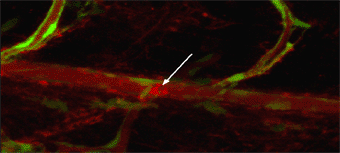A Zebrafish Model Of Atherosclerosis
Background
Heart attack and stroke are clinical consequences of atherosclerosis, an inflammatory disease of arteries initiated by lipid accumulation in the artery wall. Current animal models for atherosclerosis primarily use Apolipoprotein E (ApoE) and low density lipoprotein receptor (LDLR) knockout mice, or hyperlipidemic rabbits.. Although these models are useful once lead compounds are being tested, early assessment of new drug candidates is impractical due to the cost, slow throughput, limitations of post mortem analysis of lesions, and poor in-vivo imaging technologies that typically require use of radioactive tracers. An animal model that could provide reasonably high throughput, where the development of atherosclerotic lesions or their regression can be easily monitored while the animal is still alive, would provide significant improvement in the ability to obtain physiological information about early stage candidate compounds.
Technology Description
UCSD researchers have developed a novel zebrafish model useful for studying mechanisms of accumulation of lipid in blood vessel walls and associated vascular inflammation. This model uses a special diet enriched with cholesterol and/or knockdown of zebrafish ApoE (homologous to human and mouse ApoE) to trigger lipid accumulation in the blood vessels and atherosclerosis The vessels and lipids are easily visualized in the transparent zebrafish due to fluorescent (green) vasculature and fluorescently (red) labeled cholesterol. The model has been tested with a cholesterol lowering drug and validated for reducing cholesterol accumulation and vascular damage when the drug is present.
Advantages
- Optical transparency for 30 days allowing real time imaging of lipid accumulation and inflammatory processes in the live animal
- New drug candidates are easily administered through water or diet
- Increased throughput and more economical compared to mice or rabbits
Testing
Cholesterol accumulation in zebrafish arteries. EGFPzebrafish
larvae were fed a diet containing fluorescent (red) cholesterol ester
for 7 days. A whole live zebrafish larva was placed under a confocal
microscope to capture images of the vasculature. Green endothelial
cells help trace blood vessels, which are stained red due to high
cholesterol content in blood. Note bright red areas of the artery
(arrowhead), which indicate cholesterol accumulation in the artery wall.
Effect of anti-cholesterol drug. The addition of a commercially available cholesterol lowering drug in the fish tank water significantly reduced the level of cholesterol accumulated in the digestive system of a zebrafish, which was fed a high fat diet.

Patent Status
| Country | Type | Number | Dated | Case |
| United States Of America | Issued Patent | 9,220,243 | 12/29/2015 | 2007-014 |
Contact
- University of California, San Diego Office of Innovation and Commercialization
- innovation@ucsd.edu
- tel: View Phone Number.
Inventors
- Miller, Yury
